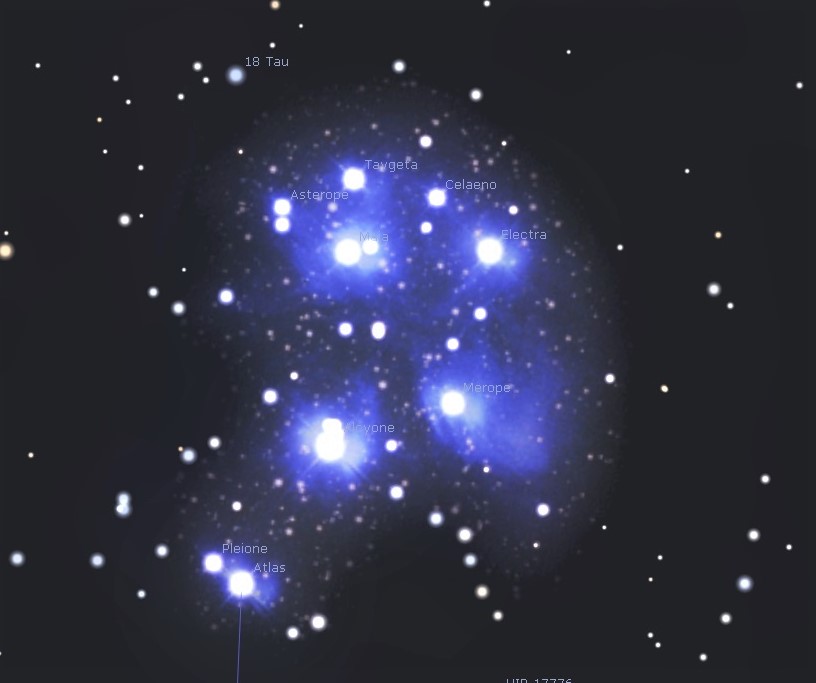This Week’s Sky at a Glance, 2022 October 8 – 15
~by Curt Nason
The Pleiades star cluster, which is located in the shoulder of Taurus the Bull, is rising by 8 pm now as a harbinger of winter. In a month it will be rising at sunset. Due to its shape, this eye-catching cluster has been mistaken for the Little Dipper. Most of us can count six stars in the Pleiades under good conditions but keen-eyed wonders have picked out twice that number from a dark sky. A low power view of it in binoculars will show a couple of dozen stars and it is one of the prettiest sights you will see in the night sky. I always look for the hockey stick in the binocular view.
According to Wikipedia, the name Pleiades likely comes from the ancient Greek word “plein,” which means “to sail.” Sailing season in the Mediterranean Sea typically began when the cluster was first spotted before sunrise. In mythology it became the seven daughters of Atlas and Pleione, hence its common name of the Seven Sisters. Somewhere along the way one of them got lost. Astronomers also know it as M45 from the Messier catalogue. The cluster played a significant role in marking time for several ancient cultures, including the Maori, Mayan, Aztec and some First Nations.
Perhaps you have seen the Pleiades while stuck in traffic and just haven’t realized it. The six-star logo of Subaru automobiles depicts the Pleiades, as Subaru is the Japanese name for the cluster. The name, which means “united,” was chosen because the large company was formed from a merger of five.
This Week in the Solar System
Saturday’s sunrise in Moncton is at 7:26 am and sunset will occur at 6:45 pm, giving 11 hours, 19 minutes of daylight (7:31 am and 6:51 pm in Saint John). Next Saturday the Sun will rise at 7:36 am and set at 6:32 pm, giving 10 hours, 56 minutes of daylight (7:40 am and 6:38 pm in Saint John).
The Moon is full on Sunday; the traditional Hunter’s Moon which, like the Harvest Moon last month, rises about 20 minutes later each evening for a week instead of the average 50 minutes. It is near Jupiter on Saturday and Mars next Friday. Mercury is at its greatest elongation from the Sun this Saturday, at its highest and best for morning observing this year. Venus is too close to the Sun for morning observing. Saturn, Jupiter and Mars are in the evening sky by 10 pm, but give Mars and extra hour or two to climb higher for better observing. Telescope and binocular users might catch the moons Europa and Io emerging from Jupiter’s shadow on Monday evening, at 7:31 and 8:43 respectively.
On Sunday evening at 8 pm, tune in to the Sunday Night Astronomy Show via the Facebook page or YouTube channel of Astronomy by the Bay.
Questions? Contact Curt Nason.

